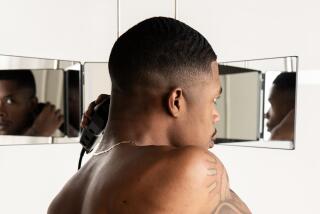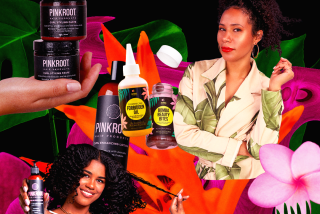From pompadour to shag, it’s women’s mane preoccupation
- Share via
The Brothers Grimm got it right nearly 200 years ago in their fairy tale: Once upon a time, women were defined by their hair and captive to those who would control them by its allure. Hair was a tool a woman wielded to land a man; without radiant locks, she might well have to abandon hope of wedded bliss. What happened, after all, to Rapunzel when the sorceress cut off her famous mane? She was separated from her prince.
Not much has changed, according to Rose Weitz, a sociologist who in “Rapunzel’s Daughters” examines the role hair plays in the lives of contemporary women. In many cases, she tells us, women continue to be defined, held captive, rated in the dating pool by their tresses and may even see their happiness as tied to the majesty of their coiffures.
This defining societal focus has its upside. Women (and their lovers) often find pleasure and sensual fun in playing with their hair -- girls love braiding and arranging one another’s locks -- and hairstyling options offer women various ways of altering others’ perceptions of them. Compared to losing weight, buying a new wardrobe or finding true love, Weitz tells us, “changing our lives by changing our hair seems downright easy.”
“Rapunzel’s Daughters” is her look at the female obsession with hair (her own obsession included) and the societal cues that fuel it. In interviews with women across the American spectrum (teens and pre-teens; mature and elderly women; mothers and wives; lesbians; heterosexual singles; women of many races), she gathers anecdotes -- funny, poignant and blithe -- that reveal the ways in which women’s hair affects how they see themselves and how their employers, lovers, spouses and others see them. The book outlines a basic history of hair from the ancient world through the Middle Ages, the Enlightenment and into the contemporary era. Weitz investigates the female bonding that has traditionally taken place in hair salons, noting that that intimacy is nowadays often found only in salons serving the black community. She gauges the effects of women’s choices to dye or not to dye their graying hair. In one of the book’s strongest chapters, she takes up the issue of female baldness. Some women choose to shave their heads and report experiencing a great sense of freedom, but those who lose their hair because of disease are devastated, and the breast cancer patients Weitz interviewed who were bald as a result of chemotherapy “mourned the loss of their hair more than the loss of their breasts.”
“Our hair is one of the primary ways we tell others who we are and by which others evaluate us, for it implicitly conveys messages about our gender, age, politics, social class, and more,” Weitz writes. Unlike our other physical characteristics, most of which we can alter only through surgery, hair is a malleable feature. A woman can exert a certain power over her life by taking control of her hair. She can manipulate her appearance with hot comb and chemicals, ponytail or purple mohawk, in some cases to call attention to herself as a rebel, outside the mainstream. Or she may wish to be seen as belonging to a certain social class or cultural group. She may want others to see her as docile and well-bred or as a sensual vixen, flipping her long, tousled mane around those she wishes to entice. Hair comes into play in the corporate boardroom, where a power haircut may make a difference as far as promotions are concerned, but if it’s too gorgeous it may also attract unwanted attention from male co-workers.
Much of what Weitz has to say seems obvious, as when she tells us that the focus on hair-care products in fashion magazines foments “dissatisfaction with our looks and our lives and help[s] convince us that we can improve our lives and change our very selves by purchasing the advertised products.” Anyone who’s ever had a bad hair day can tell you that. The book’s tone teeters between that of an academic text (for which this would be light fare indeed) and a commercial treatment appealing to a mass audience. In its attempt to straddle the gap between these realms, “Rapunzel’s Daughters” offers neither intellectual weight nor pop-culture immediacy.
Still, any woman who has found herself in tears after a bad haircut or a sub-par permanent wave will find consolation here. Weitz argues that we’re programmed -- even the most feminist and progressive of us -- for good or ill to define ourselves, and be defined, by the message of our hair.


